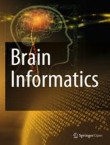Citation Impact 2023
Source Normalized Impact per Paper (SNIP): 1.543
SCImago Journal Rank (SJR): 1.016
Speed 2023
Submission to first editorial decision (median days): 13
Submission to acceptance (median days): 128
Usage 2023
Downloads: 302,950
Altmetric mentions: 141
DeepNeuron: an open deep learning toolbox for neuron tracing
Reconstructing three-dimensional (3D) morphology of neurons is essential for understanding brain structures and functions. Over the past decades, a number of neuron tracing tools including manual, semiautomati...
